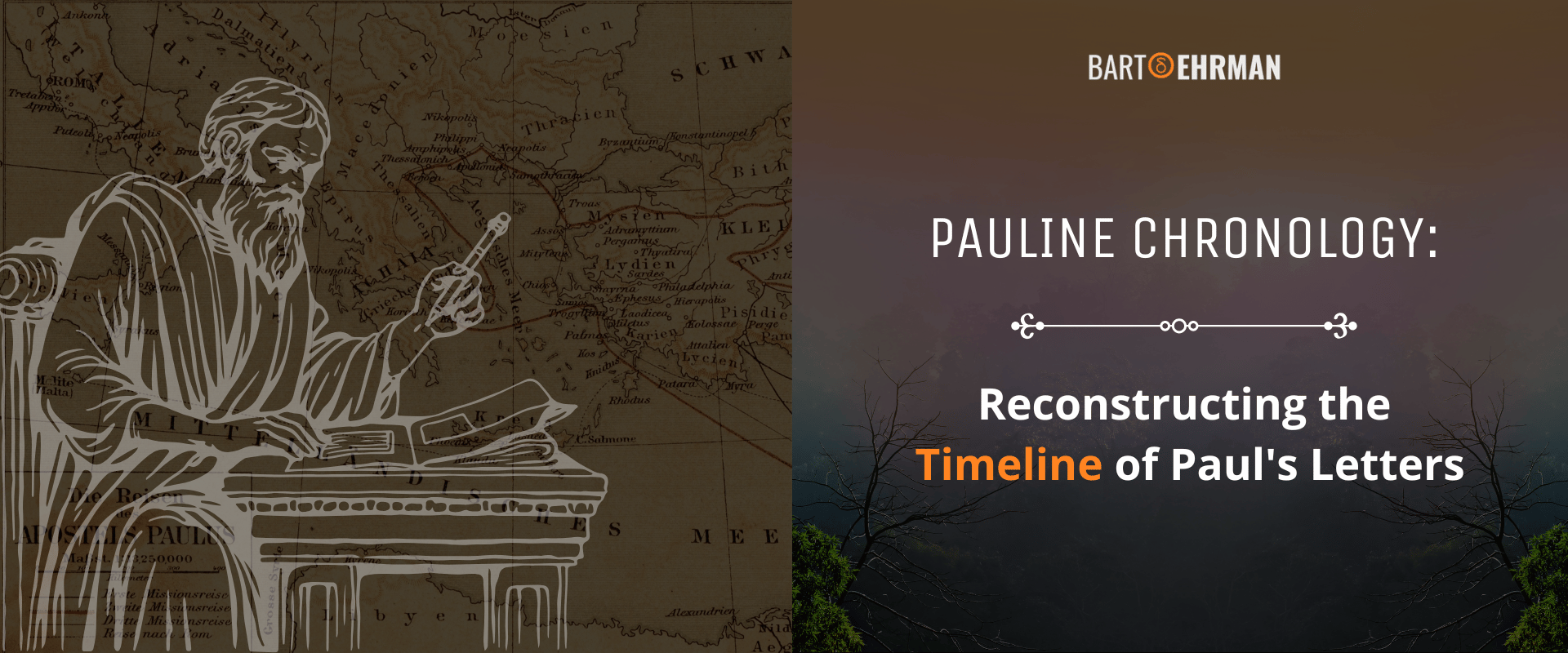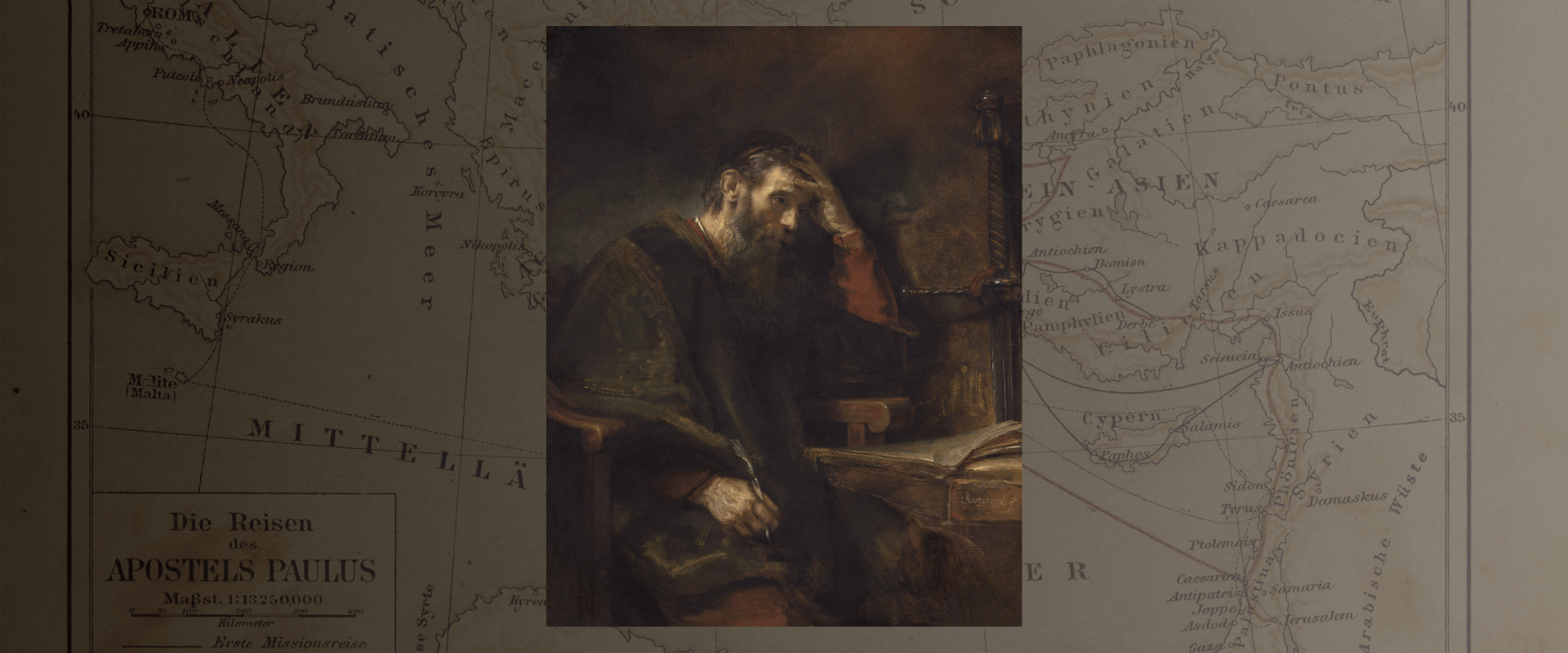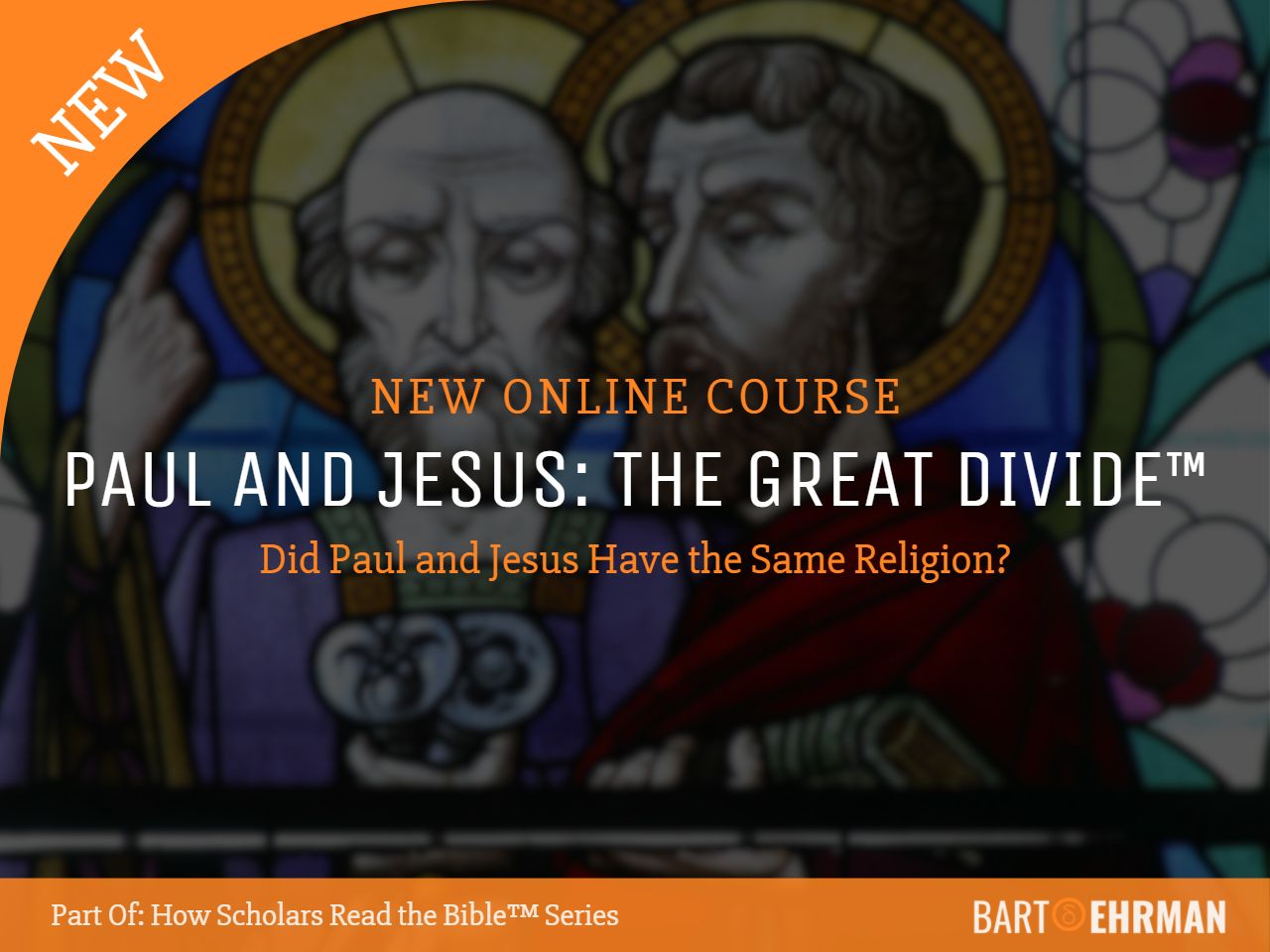Pauline Chronology: Reconstructing the Timeline of Paul's Letters

Written by Marko Marina, Ph.D.
Author | Historian
Author | Historian | BE Contributor
Verified! See our guidelines
Verified! See our editorial guidelines
Date written: March 28th, 2025
Disclaimer: The views and opinions expressed in this article belong to the author and do not necessarily match my own. - Dr. Bart D. Ehrman
A few years ago, I remember eagerly anticipating the release of Paul, the Apostle of Christ. As someone deeply invested in early Christian history, the idea of seeing an apostle Paul timeline portrayed on the big screen was genuinely exciting. But when the movie finally hit theaters, my enthusiasm gave way to mixed feelings.
While the cinematography and performances were engaging, the story leaned heavily into a Hollywood-style dramatization, missing, in my view, some of the more complex and historically fascinating aspects of Paul’s life. Still, the experience reminded me of just how central Paul remains, not only to Christian theology but to the very shape and identity of early Christianity.
And Paul's life? Nothing short of extraordinary. A staunch persecutor of the early Jesus movement who became its most zealous proponent, Paul crisscrossed the Mediterranean world, founding communities, writing letters, and enduring hardship at nearly every turn.
Yet, reconstructing an Apostle Paul timeline is no easy task. His writings offer tantalizing clues, while the Book of Acts provides a parallel (but often conflicting) narrative. The task for historians is to sift through these sources, weigh their historical reliability, and place Paul’s letters within the broader flow of his life and ministry.
In this article, we’ll walk through that reconstruction process, beginning with a brief overview of who the apostle Paul was and why his voice matters so much. Moreover, we'll focus in particular on the scholarly attempt to arrange these writings in chronological order — an effort that helps us understand the timeline of Paul.
By the end, we’ll present a working timeline of Paul’s letters alongside key events in his life. While debates remain and certainties are few, scholars have made remarkable progress in outlining the shape of Paul’s ministry.
Understanding the Apostle Paul’s timeline, even in its provisional form, offers an unparalleled glimpse into the birth of Christianity. Not as a sudden event, but as a process shaped by time, struggle, and letters.
When it comes to Paul and his influence, one thing is worth highlighting: Dr. Bart D. Ehrman offers an outstanding course titled Paul and Jesus: The Great Divide. In it, he explores the fascinating differences between the two most influential figures in Christian history — Paul and Jesus — through sharp historical analysis. Ever wondered whether the two would have seen eye to eye? If so, this course is for you. Don’t miss it — check it out today!

Contextualizing the Apostle Paul Timeline: A Brief Overview of His Life
Before we delve into our Apostle Paul timeline, it’s worth pausing to consider who he was and why his life left such a lasting mark on the development of early Christianity.
Unlike Jesus, Paul left behind a series of writings that provide direct insight into his thoughts, experiences, and theological convictions. Alongside these letters, the Book of Acts offers a narrative account of his missionary journeys and interactions with other leaders of the early Church.
While Acts supplies an interesting biographical framework, historians approach it with caution, recognizing that its theological agenda often diverges from the self-representation found in Paul’s letters.
Paul’s background is as complex as his legacy. Born into a Jewish family and trained in the traditions of Pharisaic Judaism, he described himself as zealous for the Law and blameless in its observance.
Initially, he opposed the Jesus movement and actively sought to suppress it. His transformation came through what he describes not as a conversion but as a divine revelation: A sudden and overwhelming encounter with the risen Jesus.
From that moment, Paul believed he had been commissioned to bring the message of Jesus to the Gentiles. This shift, as Larry Hurtado notes, didn’t amount to a rejection of his Jewish identity, but rather a radical reinterpretation of God's promises in light of what he understood as the climactic event of Jesus’ resurrection.
(Affiliate Disclaimer: We may earn commissions on products you purchase through this page at no additional cost to you. Thank you for supporting our site!)
The years that followed this revelatory moment were marked by intense missionary activity. Paul traveled across the eastern Mediterranean, preaching in cities like Corinth, Philippi, Thessalonica, and Ephesus.
What emerges from his writings is a deeply personal and theological vision of life in Christ. As Mark A. Powell observes in Introducing the New Testament, Paul wasn’t only the most prolific early Christian writer but arguably its most influential thinker.
His passion, rhetorical skill, and unwavering sense of purpose shaped both the communities he founded and the broader theological contours of the Christian tradition.
Understanding the man behind the letters is crucial for any attempt to reconstruct the flow of his ministry. His teachings on faith, grace, and the inclusion of Gentiles weren’t simply doctrinal positions but deeply tied to his lived experience and self-understanding as an apostle.
As Bart D. Ehrman and Hugo Mendez point out in The New Testament: A Historical Introduction to the Early Christian Writings, Paul’s insistence that Gentiles need not adopt the Jewish Law to become part of God’s people was one of the most revolutionary (and controversial) aspects of his mission.
It’s within this larger historical and theological framework that scholars have sought to piece together the sequence of his letters and journeys.
Reconstructing the apostle Paul’s timeline, then, isn’t just about dates and events. It’s about tracing the arc of a life that helped shape the very identity of Christianity in its formative decades.
Before we begin delving into Pauline chronology, let’s break down the timeline of his letters in a nice chart that will help you follow the rest of our article! We are the best, I know.
Letter | Date (Approximate) | Possible Place of Composition |
|---|---|---|
1 Thessalonians | 49-51 C.E. | Corinth |
Galatians | 52-55 C.E. | Ephesus or Macedonia |
1 Corinthians | 54-55 C.E. | Ephesus |
2 Corinthians | 55-56 C.E. | Macedonia |
Philippians | 54-56 or 60-62 C.E. | Ephesus or Rome |
Philemon | 54-56 or 60-62 C.E. | Ephesus or Rome |
Romans | 56-57 C.E. | Corinth |
What Is the Chronological Order of the Pauline letters?
Paul’s impact on early Christianity is preserved most tangibly in the letters that bear his name — thirteen epistles in total, forming a foundational part of the New Testament. Scholars typically classify these writings into three categories based on linguistic style, theological content, and historical context:
#1 – The seven undisputed letters
#2 – Deutero-Pauline Epistles
#3 – Pastoral Epistles
The stylistic and conceptual distance between these groups of letters reflects different phases of early Christian development and the influence of Pauline school traditions.
Needless to say, only the first group goes back to the historical Paul. Other letters were probably written after his death by later followers who tried to back up the claims they made by identifying themselves as Paul.
Furthermore, in his book Einleitung in das Neue Testament (Introduction to the New Testament), Udo Schnelle notes:
“The Pauline letters are part of a comprehensive process of communication between the apostle, his disciples, and the various mission communities. Paul provided his co-workers and churches with solutions to disputes, forward-looking theological reflections, and ethical instructions, while he himself was significantly influenced in his thinking by his collaborators and by changing community situations” (my translation)
Understanding the basic information about this literary corpus, therefore, is essential before attempting to map Apostle Paul’s timeline.
While all thirteen letters are included in the New Testament canon, not all can be used equally as historical sources. The seven undisputed letters form the bedrock of any reconstruction of Paul’s chronology, offering relatively direct windows into specific moments of his ministry. For that reason, we’ll focus on those and leave the rest for future articles!
Timeline of Paul’s Letters: A Scholarly Reconstruction
When it comes to reconstructing the sequence in which the apostle Paul wrote his letters, scholars generally operate within two competing models. The traditional view follows the structure of Paul’s missionary journeys as outlined in Acts, aligning them with references in his epistles.
In contrast, revisionist models suggest earlier or alternative datings. A smaller but influential group of scholars supports this approach. Their reconstructions depend heavily on different dates of Jesus' crucifixion and differing levels of trust in Acts versus Paul's letters.
Raymond E. Brown, in his An Introduction to the New Testament, outlines both approaches, but ultimately supports the traditional model, in which Paul’s major letters were composed between roughly 50 and 58 CE. Still, as Brown notes, precise dating remains elusive.
Still, as Brown notes, precise dating remains elusive. Even with careful source analysis, any Pauline chronology remains provisional — an educated guess at best!
The one widely accepted anchor point is his appearance before Gallio, the Roman proconsul of Achaia (Acts 18:12-17). This event provides a rare fixed point in the New Testament chronology. As Daniel Marguerat explains in his recent monograph, Paul de Tarse (Paul of Tarsus):
“Dating Gallio’s proconsulship is possible thanks to an inscription discovered at Delphi and published in 1905, in which Emperor Claudius refers to ‘my friend Lucius Junius Gallio.’ On this basis, it can be established that Gallio arrived in Corinth in May/June 51, beginning his tenure in early summer – or perhaps as early as spring 52. Since Paul remained in Corinth for a year and a half during his second missionary journey (Acts 18:11), it follows that he arrived in the city by land around late 49 or early 50 and departed around 52. The entire Pauline chronology hinges on this single anchor point.” (my translation)
With this benchmark in place, most scholars agree that 1 Thessalonians is likely the earliest of Paul’s extant letters, written from Corinth around 50–51 CE. The letter addresses a young Christian community in Macedonia that Paul had recently founded but was forced to leave due to persecution.
Paul’s next surviving letters, 1 and 2 Corinthians, were likely written between 53 and 56 CE, during his extended stay in Ephesus and later travels through Macedonia.
1 Corinthians addresses internal divisions, moral lapses, and questions about marriage, spiritual gifts, and the resurrection, while 2 Corinthians reveals a more personal and vulnerable Paul who defends his apostolic authority and criticizes the so-called “super-apostles.”
Galatians, though harder to date precisely, was likely written between 52 and 55 C.E., either before or just after 1 Corinthians. The debate hinges on whether Paul was addressing communities in northern or southern Galatia — a question with implications for the letter’s place in his itinerary.
Regardless, the epistle is a fiery defense of his gospel: Salvation by faith in the resurrected Jesus apart from the works of the Law. More specifically, Paul insists Gentile believers need not adopt Jewish practices such as circumcision, a claim that placed him at odds with other early Christian leaders.
The dating of Philippians and Philemon presents a particularly interesting scholarly challenge, as Paul wrote both letters while in prison. Yet, the precise location and time of that imprisonment remain uncertain.
The traditional view holds that these two letters were composed during Paul’s Roman imprisonment around 60-62 C.E., a position supported by the narrative at the end of Acts (28:16-31). This dating would make these letters among the final texts written by Paul before his presumed execution under Nero.
However, some contemporary scholars argue for an earlier date and different location, suggesting that both letters were written during a previous imprisonment in Ephesus, likely between 54 and 56 C.E.
Udo Schnelle, for instance, affirms this as a viable alternative, noting that recent scholarship increasingly favors Ephesus as the place of composition.
Daniel Marguerat is more cautious, summarizing the debate and arguments by focusing on the Epistle to Philemon:
“Paul, co-author with Timothy, refers to himself as a “prisoner of Christ Jesus” (Philem 1). A prisoner in Rome? A prisoner in Ephesus? Against the Ephesian hypothesis stands the fact that Paul describes himself as old (Philem 9) and that no imprisonment in Ephesus is otherwise attested. Against the Roman hypothesis, scholars cite the considerable distance – two thousand kilometers – between Colossae and Rome, which would have significantly extended Onesimus’ journey to reach Paul. In reality, as with the Letter to the Philippians, nothing is certain (on n'est sûr de rien). I remain with the traditional thesis of Roman captivity. In any case, the location has no real impact on the interpretation of the text. However, the dating does vary depending on the location: 53–55 if the letter was written from Ephesus, 60-62 if it was written from Rome.” (my translation)
While certainty remains out of reach, acknowledging both options allows us to appreciate the fluid and context-dependent nature of Pauline chronology.
Finally, Paul’s Letter to the Romans! Günther Bornkamm famously referred to it as “Paul’s testament.”
Why? Basically, it’s the closest we can get to the systematic outline of Paul’s theology. As Mark A. Powell notes, Romans represent “a good starting point for understanding Paul precisely because it offers a mature and articulate presentation of some of his key ideas.”
Similarly, Marguerat explains:
“But it is testamentary in the sense that it offers Paul’s synthetic presentation of Christian identity – one to which the apostle would not return again in his lifetime. Numerous themes addressed earlier are taken up once more and developed in greater depth.” (my translation)
So, how does Romans fit into the apostle Paul timeline? Well, it was likely written from Corinth around 57 C.E., as he prepared to bring the collection from his Gentile churches to Jerusalem.
In his Commentary on Romans, Robert Jewett notes:
The fluctuating dates require an examination of the various pieces of evidence on which the chronology of the latter part of Paul’s career rests. In the case of the Edict of Claudius, its placement has a bearing both on the date for the composition of Romans and on the history of the Roman congregations prior to Paul’s intended visit. When this and other data are weighed, the conclusion will emerge with a relatively high degree of probability that Romans was drafted in the winter of 56-57 C.E. or the early spring of 57.
As such, Romans stands not only as a theological synthesis of Paul’s gospel but also as a carefully timed appeal to a community he hoped would support the next phase of his mission — a letter shaped as much by doctrinal conviction as by strategic foresight at a pivotal moment in his ministry.

Apostle Paul Timeline: Chart
Before we conclude our exploration of the Apostle Paul timeline, we thought it would be helpful to provide a concise overview of the key events in his life just to give you (our favorite readers!) a clear sense of how his ministry unfolded in real historical circumstances!
Event | Date | Notes |
|---|---|---|
Birth | C. 5-10 C.E. | Possibly born in Tarsus. |
“Conversion” Experience | C. 33-36 C.E. | Vision of the risen Jesus; radical shift in mission and theology. |
First Visit to Jerusalem | C. 36-39 C.E. | Met with Peter and James (Gal 1:18-19). |
Mission in Antioch | Early 40s | Gentile mission. |
Council of Jerusalem | C. 49 C.E. | Key debates over Gentile inclusion. |
Galio’s Proconsulship (Anchor Point) | 51-52 C.E. | A fixed point in Pauline chronology. |
Transfer and House Arrest in Rome | C. 60-62 C.E. | According to Acts, Paul waited trial before Caesar. |
Death (possibly martyrdom) | C. 64-67 C.E. | Later sources claimed it happened under the Emperor Nero. |
Conclusion
Reflecting on my experience watching Paul, the Apostle of Christ, I now recognize more clearly why the film (despite its dramatic strengths) left me wanting more. What was missing, I believe, was the intricate, historically grounded picture that emerges when we examine Paul not just as a saint or martyr but as a complex, dynamic historical figure.
His letters, written across the span of a turbulent and demanding life, are not isolated theological tracts but deeply contextual pieces of communication. By stepping into the world behind those writings (his travels, his imprisonments, his interactions with communities), we begin to see just how remarkable and layered the apostle Paul’s timeline truly is.
And yet, this timeline remains, in many ways, a puzzle in motion. While the traditional model offers a coherent narrative, it cannot claim final certainty. Scholarly debate continues, fueled by new readings, archaeological discoveries, and evolving methods of interpretation.


